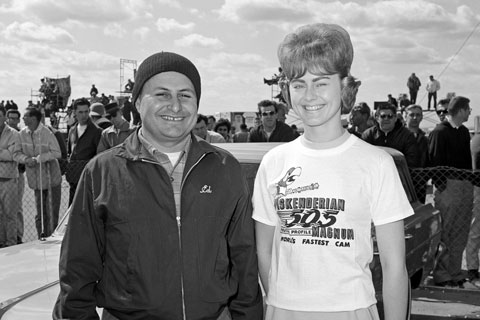SEMA News - August 2010
By Drew Hardin
Photo Courtesy Source Interlink Media Archives
 |
|
Hilborn, too, was a dry lakes racer in those pre-World War II years, running a Model A roadster with a Ford V8 built by Eddie Miller. Hilborn’s speeds were in the 120-mph range, and he was no doubt looking to go faster when he heard that Warth’s race car was for sale. Hilborn paid $75 for the car—without the engine and transmission—and picked it up from Warth on December 7, 1941, the day Japan bombed Pearl Harbor.
Hilborn and Miller put a V8 in the car and raced it a couple of times before Hilborn entered the Army Air Corps, storing the ’liner for the duration of the war. While in the military, he began experimenting with his ideas for fuel injection, but it wasn’t until after the war that he was finally able to apply them to race cars—not just his streamliner but also to midget racers and, later, to Indy roadsters.
By 1947, Hilborn was pushing his ’liner to nearly 140 mph, alternating between a fuel-injected manifold and multiple-carb setups. During a test of a carbureted manifold in August of 1947, one of the streamliner’s 18-inch Ford wheels collapsed at speed. The car rolled several times, and injuries to Hilborn’s back put him in a body cast.
Surprisingly, the car was not a total loss. While Hilborn recuperated, Eddie Miller Jr. hammered it back to its original shape. Hilborn promised his mother that he wouldn’t race again, so hired gun Howie Wilson drove the ’liner in 1948 while Hilborn continued to develop his new induction system. The sleek black streamliner attracted the attention of Hot Rod magazine’s editors, who featured the car on the cover of its April 1948 issue. In July 1948, with fuel injection feeding the V8, Wilson became the first to break the 150-mph barrier with a one-way pass of 150.5 mph across El Mirage Dry Lake.
It took another year for Hilborn injection to qualify a car at Indy, and three more before a Hilborn-fed car won the 500. But Troy Ruttman’s 1952 win was the first of 34 eventual Indy 500 victories for Hilborn’s injection system, and his name has since become nearly synonymous with the induction he developed with this second-hand streamliner.






